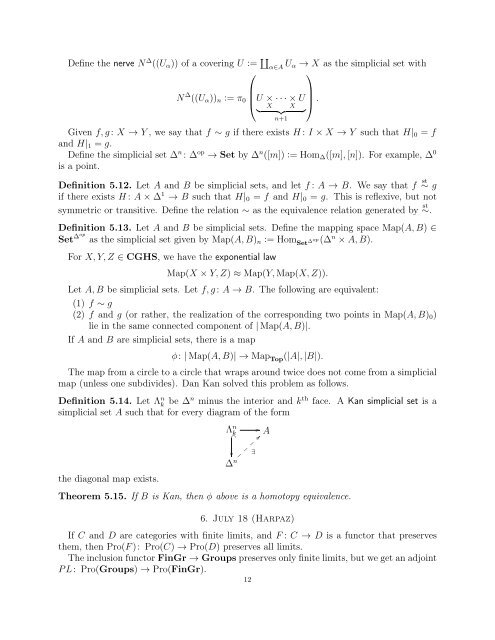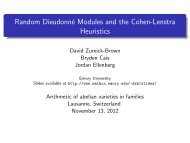alternative lecture notes - Rational points and algebraic cycles
alternative lecture notes - Rational points and algebraic cycles
alternative lecture notes - Rational points and algebraic cycles
You also want an ePaper? Increase the reach of your titles
YUMPU automatically turns print PDFs into web optimized ePapers that Google loves.
Define the nerve N ∆ ((U α )) of a covering U := ∐ α∈A U α → X as the simplicial set with<br />
⎛<br />
⎞<br />
N ∆ ((U α )) n := π 0<br />
⎜<br />
⎝ U × · · · × U⎟<br />
X X<br />
⎠ .<br />
} {{ }<br />
n+1<br />
Given f, g : X → Y , we say that f ∼ g if there exists H : I × X → Y such that H| 0 = f<br />
<strong>and</strong> H| 1 = g.<br />
Define the simplicial set ∆ n : ∆ op → Set by ∆ n ([m]) := Hom ∆ ([m], [n]). For example, ∆ 0<br />
is a point.<br />
Definition 5.12. Let A <strong>and</strong> B be simplicial sets, <strong>and</strong> let f : A → B. We say that f ∼ st<br />
g<br />
if there exists H : A × ∆ 1 → B such that H| 0 = f <strong>and</strong> H| 0 = g. This is reflexive, but not<br />
symmetric or transitive. Define the relation ∼ as the equivalence relation generated by ∼.<br />
st<br />
Definition 5.13. Let A <strong>and</strong> B be simplicial sets. Define the mapping space Map(A, B) ∈<br />
Set ∆op<br />
as the simplicial set given by Map(A, B) n := Hom Set ∆ op (∆ n × A, B).<br />
For X, Y, Z ∈ CGHS, we have the exponential law<br />
Map(X × Y, Z) ≈ Map(Y, Map(X, Z)).<br />
Let A, B be simplicial sets. Let f, g : A → B. The following are equivalent:<br />
(1) f ∼ g<br />
(2) f <strong>and</strong> g (or rather, the realization of the corresponding two <strong>points</strong> in Map(A, B) 0 )<br />
lie in the same connected component of | Map(A, B)|.<br />
If A <strong>and</strong> B are simplicial sets, there is a map<br />
φ: | Map(A, B)| → Map Top (|A|, |B|).<br />
The map from a circle to a circle that wraps around twice does not come from a simplicial<br />
map (unless one subdivides). Dan Kan solved this problem as follows.<br />
Definition 5.14. Let Λ n k be ∆n minus the interior <strong>and</strong> k th face. A Kan simplicial set is a<br />
simplicial set A such that for every diagram of the form<br />
the diagonal map exists.<br />
Λ n k <br />
∆ n<br />
A<br />
<br />
<br />
<br />
∃<br />
Theorem 5.15. If B is Kan, then φ above is a homotopy equivalence.<br />
6. July 18 (Harpaz)<br />
If C <strong>and</strong> D are categories with finite limits, <strong>and</strong> F : C → D is a functor that preserves<br />
them, then Pro(F ): Pro(C) → Pro(D) preserves all limits.<br />
The inclusion functor FinGr → Groups preserves only finite limits, but we get an adjoint<br />
P L: Pro(Groups) → Pro(FinGr).<br />
12



